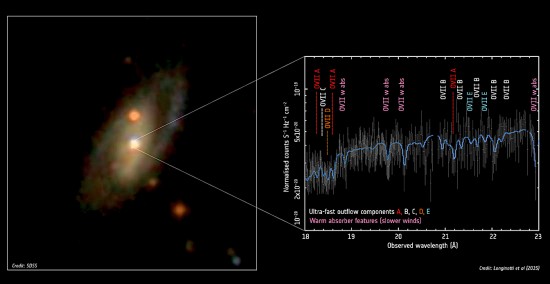
Rapid outflow from IRAS17020+4544. Image: Sloan Digital Sky Survey; Spectrum: Longinotti et al. (2015)
Sep 6, 2016
X-rays are not created by pressure.
According to a recent press release, a black hole in the center of galaxy IRAS17020+4544, about 800 million light-years from Earth (as astronomers measure distance via redshift) is almost six million Suns in mass. The most important aspect to the announcement in that “….winds from around the black hole are moving at 23 000–33 000 km/s, about 10% the speed of light.”
The idea that electricity flows through the Universe is commonly met with resistance in the modern consensus, so its attributes are unseen. It has long been said that “seeing is believing.” However, it should not be surprising that “believing is seeing” is more appropriate. When there is no inner context for thought, outer realities often remain invisible.
Conventional theories rely on gravity and acceleration to explain radiation in space. Compressing hydrogen gas and dust is supposed to create enough transfer of momentum that it reaches millions of degrees. It is that high temperature that is supposed to make it glow so brightly.
For example, the Chandra X-ray Telescope found ionized material pouring out of the Crab Nebula, emitting X-rays. In another announcement, astronomers reported that two giant stars in Eta Carinae were blowing off “intense winds.” The winds are so powerful that the collision of the wave fronts is thought to be generating X-rays where the shells intersect.
All of these effects are supposed to be due to kinetic shock, even though the researchers acknowledge that the observed “wind” is ionized particles. Despite that understanding, researchers persist in the use of “billiard ball physics”: electrons bounce back and forth in magnetic fields until they impact low-frequency photons, imparting so much energy that they become X-rays.
From the Electric Universe perspective, those magnetic fields do accelerate electrons, but since the electrons spiral in the field, they emit synchrotron radiation. To the detectors observing stars, synchrotron radiation appears as X-rays.
Electric currents surge out along galactic spin axes, forming double layers that can sometimes be seen as radio or X-ray “lobes.” The currents spread out around the galactic circumference, flowing back to the core along the spiral arms. All the elements in a galactic circuit radiate energy. That energetic radiance shows that they are powered by larger circuits. Galaxies occur in strings, and the extent of the larger circuits may be traced by radio telescopes from their polarized radio “noise.”
Plasma’s behavior is governed by electric circuits. Double layers with large potential voltages between them often exist. The electric forces in double layer filaments can be much stronger than gravity. Those filaments can also have different temperatures or densities. Double layers broadcast radio waves over a wide range of frequencies. They can sort galactic gas and dust and then condense it. Most significant to the ESA bulletin, they can accelerate charged particles to extreme energies.
This vision of the cosmos sees various components coupled to and driven by circuits at ever larger scales. Electrons and other charged particles accelerating through intense electric fields radiate “shouts” of energy in many bandwidths. The power of those currents can sweep up neutral gas and dust as they move through a galaxy.
Stephen Smith












